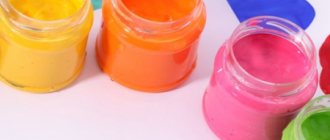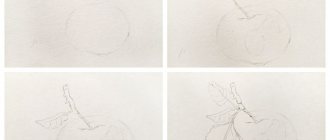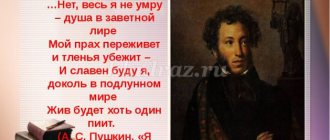Senior group. Senior preschool age. Children 5-6 years old
Summary of educational activities on drawing for children 4–5 years old “Feather of the Firebird” Summary of educational activities on drawing for children 4–5 years old on the topic “Feather of the Firebird”
Educator: Koldomasova Tatyana Nikolaevna.
Goal: To develop the ability to independently create a pattern using familiar drawing .
Objectives: - Improve the grammatical structure of speech. — Teach creatively and... Notes on non-traditional drawing (Ebru technique) in the senior group “Salute in honor of the Victory” Goal: Integration of educational areas: “social and communicative development”
,
“cognitive development”
,
“speech development”
,
“artistic and aesthetic development”
,
“physical development”
;
Educational field “Social communicative development”
Educate preschoolers in…
Technological maps for designs of clothing, shoes and hats
The reference lines for clothing designs are straight lines intersecting at an angle and resembling letters.
Table: drawing diagrams of wardrobe elements for older preschoolers
| Theme of the drawing | Description |
| "Summer Wardrobe" | T-shirt
Shorts
Dress (blouse)
|
| "Cap" |
|
| "Dress for a doll" |
|
Photo gallery: samples of clothing patterns
If you make the dress shorter, you get a blouse, and if you lengthen the shorts, you get trousers
To draw woolen items you need to make soft transitions of elements
This dress is drawn based on a vertical line in the center of the image.
Photo gallery: templates for decorating and coloring clothes
Children can choose their own pattern for coloring the shirt
An additional task for coloring a dress can be a selection of decorative elements
Children with mental retardation can be given the task of coloring their skirt in a certain color, trying not to go beyond the boundaries of the image.
Based on this coloring book, children can come up with stories about where they have been and what fairy shoes they have seen.
You can use wax crayons to color the mittens.
While coloring a straw hat, children practice different types of shading
Video: master class on drawing winter hats
Video: master class on drawing shoes
Video: master class on drawing an elegant dress for a doll
Video: master class on drawing and painting a national costume
Drawing clothes, hats and shoes in the senior group gives children initial ideas about modeling wardrobe items and teaches them how to create original prints based on geometric patterns. Children improve their visual skills, practice the ability to use a brush and pencils to create images of varying degrees of color intensity, and expand their knowledge of the history of national costume. In addition, templates for drawing clothes are used in working with children with mental retardation.
Notes on drawing for the senior group “In the world of goodness”
Notes on drawing for the senior group “In the World of Good” Purpose:
To deepen children’s understanding of kindness as a valuable, integral quality of a person, to encourage the child’s desire to do good deeds. Improve communication skills (the ability to listen to friends, express your opinion, show kindness to the opinions of other children). Teach children productivity skills.
Tasks:
Continue to cultivate interest in visual arts; Strengthen technical skills (strengthen the ability to hold a brush correctly); Arouse a positive response to the results of your creativity; Develop creativity, the ability to work independently, and cultivate accuracy in work.
Integration of educational areas:
Social and communicative development, speech development, artistic and aesthetic development, cognitive development, physical development (in accordance with the Federal State Educational Standard).
Methodical techniques:
1. Artistic word. 2. Musical accompaniment. 3. Teacher’s explanation. 4. Observing children's work. 5. Analysis of work by the teacher and children. 6. Psychological game with a psychologist.
Material and equipment:
Artificial flowers, a ball, a computer, one large balloon, an envelope with a letter, multi-colored picture pieces (puzzles), decorations for a multi-colored country of kindness (flowers, autumn leaves), ½ album sheets for each child, gouache, brushes, cups of water , stands for brushes, a large soft sun toy, geometric shapes made of multi-colored cardboard, a ladybug toy, pink and purple cards for each child, paper hearts, helium balloons for each child.
Preliminary work:
Reading the story by V. Mayakovsky “What is good and what is bad” Examination of illustrations, organization of children by the teacher for didactic and speech games, discussion of the actions of the heroes.
— Progress of the lesson:
(the children, together with the teacher, enter the bedroom and stand in a semicircle.) Educator:
Guys, I want to introduce you to our guests.
Teachers from the Zvezdochka kindergarten came to see us today. Greet them. (children say hello)
. Now, guys, please tell us about yourself.
We are all friendly guys, We are preschool kids, We don’t offend anyone, We know how much we care, We won’t leave anyone in trouble, We won’t offend, but we’ll ask. Let everyone be well. It will be joyful, light!
Educator:
Guys, please look out the window.
The sun is shining, the sky is blue, the grass is green. When does this happen? (in summer)
Notice how many flowers are on the windowsill.
Do you like flowers? (yes) (hands out one flower at a time, saying)
What can you do with flowers?
(admire, smell, give...)
Such wonderful flowers, they smell nice, I invite you to inhale their scent.
(music No. 1. Breathing exercises: children inhale with their mouths closed, then exhale through their mouths 3-4 times.) Educator:
How many flowers do you have
Vika
, and
Egor
?
(one...)
And if we all connect flowers together, how many will there be?
(a lot...)
And when there are a lot of flowers, what is it?
(bouquet)
That's right, well done, of course a bouquet.
I suggest giving our bouquet to our guests. (given by one child)
Dear children, you are the most beautiful in the world:
Seryozhechka is
a friend,
Nikita
a twinkle,
Milanochka
is a friend and
Nellya is a laughing one...
Guys, I suggest you play the game “Tender Word”.
(takes the ball, the children stand in a semicircle...teacher: I like Nikita because you are brave...and Alina has a beautiful smile, etc.)
Do you think, children, is it nice to say kind words?
(yes)
What about the evil ones?
(no)
I invite such good, handsome people on a journey.
Want to? (yes)
Think and tell me, what can you travel on?
(by car, boat, plane, balloon...) (a balloon flies in) Educator:
Miracles, guys, the balloon itself flew to us!
Yes, there is also a letter!!! (opens it and takes it out)
What kind of letter is this?
I'll read it! (read: Dear guys! I invite you to take a fascinating journey through the extraordinary “Colorful Country of Kindness!”)
Who is the letter from?
Who is inviting us? There are some colorful pieces in the envelope...what should I do with them? Children: (collect) (collected, recognized the Fairy of Kindness) Educator:
Who sent the letter is now clear!
This is the mistress of the country of “Kindness.” Well, you can hit the road. In this balloon we will fly to the “Colorful Country of Kindness”. (music No. 2 sounds) (Children, together with the teacher, holding a large balloon to the music, move to the decorated group) Educator:
Guys, we are greeted by the Fairy of Kindness herself!
Fairy: Says hello to the children. Educator:
Your kindest Majesty, why are you sad and why is it so dark in your country?
Fairy
: Recently, an evil wizard came to our Multi-Colored Country, he really doesn’t like paints, and so he took them and hid them behind seven locks.
Guys, help us light the sun! Educator:
Our preschool children are very kind children, children, you agree to help the Fairy of Kindness!
(yes) Educator
: Children, sit down, let's help the Fairy light the sun.
(Music No. 3 sounds. Children paint the image of the sun with paints on ½ album sheet.) Fairy:
Well done, guys!
Thank you guys. So the sun has lit up (shows a large soft toy sun)
Here it is again in our country it has become light and sunny!
Educator:
It’s become light and sunny, which means you can play!
Guys, stand in a circle. (physical exercise to music No. 4) Educator:
Look, I found unusual leaves, they have different geometric shapes!
What is the shape of this leaf? (circle)
What color is the circle?
( yellow)
What kind of figure is this?
(triangle)
What color is the triangle?
(green)
Look guys, here’s a bug!
But we didn’t notice him right away. Help the bug choose a leaf on which it would be noticeable. (music No. 5 plays. Children put a bug on leaves of different colors and compare on which color the bug will be most noticeable.) (yellow) Fairy:
Well done, my mood has even improved.
Do you guys know that every color has its own mood? (we know...yes) Educator:
I suggest you play the game “pick the color to suit your mood!”
(I distribute purple and pink cards to each child)
I will read the poems of Vladimir Karkin, and you will select a card of the appropriate color and hold it up.
(music number 6 sounds)
There is fog and slush outside the window The stars are hiding in the darkness I really want to cry I don’t know why Guys, what color card will you choose?
(purple)
Correct….
(music number 7 sounds)
In the morning the branches turn golden In the blue smoke like a dream I really want to laugh I don’t know why And now what color card will you choose?
(pink)
Of course, everyone is in a great mood!
Fairy:
I’m in a great mood, because friendship and kindness work real miracles!
Let's hold hands and feel the warmth and strength of our friends' hands. (reads a poem. psychological game)
The breeze is friends with the sun, and the dew is with the grass. A flower and a butterfly are friends, you and I are friends. We are happy to share everything in half with friends! Just never quarrel with friends!
Educator:
I’m looking at you now, you’re all smiling...What’s your mood after our trip?
(Good)
So paint your mood in color!
(They paint hearts in different colors to music No. 8) Educator:
And now, dear Fairy of Kindness, accept from us a rainbow of our good feelings as a souvenir!
(children give colorful hearts). Fairy:
Thank you, good guys.
And so that you return safely, I will give you magic balloons on which you will fly to your favorite kindergarten. (music No. 9 sounds. The fairy hands out balloons and the children fly into the bedroom).








